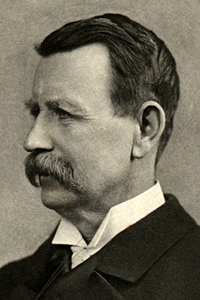In 1986, while Ateret Cohanim was already moving forward with property purchases, another organization, Elad, was getting its start in a different part of the city.

A map showing the City of David relative to the Old City. Note that it is to the south east, immediately outside the Old City walls.
The walls of Jerusalem's old city today, built in the 1500s encompass most of the ancient city as it was during the period of the second, rebuilt temple period, from 422 BCE until 68 CE. Today, as a result of geography and layer upon layer of building, the Holy Temple, itself buried under the Al Aksa Mosque, is at the lowest geographical point in the city. But we know from reading of the Tanach that one had to ascend to the temple from Jerusalem, not descend. This would indicate that the ancient biblical city of Jerusalem, the City of David, was located somewhere below the temple mount.
In 1873, acting on this information, a young explorer, the British Captain Charles Warren, surmised that the City of David was located south of the walled city, below the temple mount, along a fingernail-shaped sliver of land.

Sir Charles Warren
Warren pioneered new techniques of digging and exploration in peeling away the layers of debris covering the City of David, a technique which would later become the field of archaeology. Among his discoveries were the network of tunnels used by King David and his soldiers to invade Jerusalem.
 An illegibly low-resolution cross-section of Warren's Shaft, Sir Charles Warren's discovery of the shaft through which King David and his soldiers conquered the city.
An illegibly low-resolution cross-section of Warren's Shaft, Sir Charles Warren's discovery of the shaft through which King David and his soldiers conquered the city.During the period of Zionist land reclaimation in the early 20th century, the Jewish National Fund, using charity funds collected from Jews all over the world, purchased the then empty ruins of the City of David. Despite the strong desire to continue digging and exploring, fate intervened and the land fell under Jordanian occupation from 1948 until 1967. By the time of the city's recapture, dozens of Arab apartment buildings had already sprung up over the land.

The entrance to the new visitor's center, looking back at the old city walls. Note the minnaret poking over the wall on the far right of the photo. It's the Al Aksa Mosque, over which the Islamic world has launched innumerable wars.
In the early 1980's, while the area, now called Silwan, was still under Israeli soveriegnty, law enforcement in the area was lax, and any police actions had to be carried out by undercover military agents dressed as Arabs. One of these agents who knew the history of the land he was walking on felt it was a shame that Jews could only visit this place, the holiest city in Jewish history, in complete secret for fear of a violent Arab response. After completing his service, he returned to the City of David and attempted to convince the Jewish National Fund, now the Jewish Agency, to press its claim for the City of David. While the absentee tenant laws made it clear that the Arabs now living there could not be evicted, there was a desire to at least save the areas of the city which had not yet been built upon and begin archaeological excavations. The Jewish Agency was uninterested in pressing their claim due to the raging political contraversy and endless legal battles which were sure to ensue. The retired soldier then started an organization known as Elad, which collected donors and purchased the title from the Jewish Agency, then began the lengthy legal proceedings to claim the remaining empty land.
After successfully claiming the city's empty land and beginning excavations, the Elad organization began purchasing apartment blocks throughout the City of David one by one, much as their sister organization, Ateret Cohanim, was doing in the Old City. There is currently almost a demographic balance between Jews and Arabs in the City of David.

Looking between my toes at an ongoing excavation of the main road which led from the City of David to the Holy Temple.
Meanwhile, archaeological excavations continue unearthing biblical sites.

Saying morning prayers while guarding the newest excavations.

There was still some snow on the ground when I took these pictures a couple of months ago. (Just thought I'd throw that in there.)
No comments:
Post a Comment